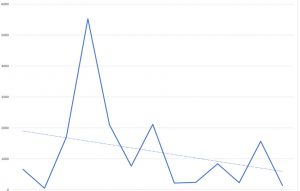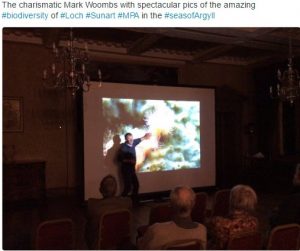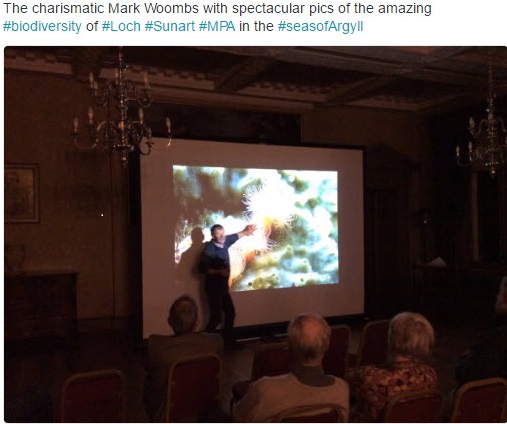Half price: Not long ago, an industry representative based in China suggested that salmon could be sold for over NOK 100/kg. Now just nine weeks into the new year, prices in Norway may have plunged to half of that price with Undercurrent News reporting that prices could be low as NOK 50/kg for deliveries in Oslo in week 10. It is uncertain when prices might recover. There is a lot of guesswork as to where prices will be by Easter.
We, at Callander McDowell think that this ongoing decline in prices has caught out several analysts and commentators. We have previously pointed out that it is one thing to predict the market from graphs detailing biomass and sales, but these do not consider what consumers will do.
It was inevitable that sustained high price levels would eventually impact on the retail sector. Since New Year, most UK supermarkets have increased prices. Typically, the greatest increases have occurred at stores serving the more price conscious customers. This is because prices had been held low, increasing the disparity between what the stores paid and the price they charged their customers. Stores at the top end of the market, used to charging higher prices have shown little, or even no price movement.
There is some debate whether these increases will deter consumer spending. One leading industry captain once said that a few pence per pack will make little difference, but the reality is that at the lower end of the market, it does.
These price increases are now coming at a time when prices generally are falling. Have the stores been a bit premature in putting up their prices. The same happened a few years ago, when prices went up above the usual levels. Stores increased prices just as the market price was in decline.
What happened then was that stores held prices on most of their lines but ensured that one offering was at a lower price. This week, we came across one supermarket chain doing exactly this and offering a price cut on one product. A 130g salmon portion normally priced at £2.50 is now selling for £2. We expect to see other stores follow in the coming weeks.
This year, prices are more difficult to predict in the UK because other factors also come into play. Salmon prices may have increased, but so have other fish prices. Some of these have now come down, whilst others are still going up.
We suspect that whatever happens to prices, the fish industry may find it more difficult to persuade shoppers to buy fish this year.
Pressing the point: It seems that anyone with a grudge against something can simply create a press release that is immediately reproduced in the press. We are not sure what happened to investigative journalism as it appears that some of the press no longer seem to check the facts, relying instead on the word of others.
Since the New Year there has been a constant stream of articles in various parts of the press, all of which it appears have their origins, in one way or another, from a single source. This source relies on Freedom of Information requests to gather material, usually aggregated over many years to enhance the impact on the public.
Although the information is supplied by a Government agency, the way it is presented is typically distorted to paint the salmon industry in the worst possible light. Inevitably, salmon farming does have some impact on its surroundings but so does everything man does too. In the case of salmon farming, forty years of negative publicity means that some of the public believe everything that is said, even facts that are now known to be incorrect. We know from our own experience that the facts don’t always match the claims made.
We want to consider the reality behind two of the latest ‘stories’ that have appeared in the Scottish press. The first was published in last week’s Sunday Herald. It was given even more gravitas by being splashed across the front page of the paper. The headline was ‘45 Scottish lochs trashed by pollution’. The story was based on routine sampling of the seabed undertaken by the Scottish Environmental Protection Agency. In some cases, they reported that anti-parasitic medication was detected in the vicinity of salmon cages. The paper spoke to experts who detailed the damage that these treatments could do to human health and the environment.
However, what the paper failed to do was to cite one single example of this so-called pollution and by how much it had breached the limits set by SEPA. Past experience suggests that when the salmon industry has breached limits by a significant amount, blue murder is screamed with the loudest voice possible. As even the smallest breach was not reported in the paper, we can only conclude any breaches detailed in the FOI data are not significant. Of course, any breach is regrettable and unacceptable but whether it merits front page headlines is something else. It’s just easy journalism.
The second example highlights the ease at which official data is distorted to create a story out of nothing. The Press & Journal recently published a story claiming farmed salmon are addicted to a cocktail of chemicals and more specifically antibiotics. Another Freedom of Information request provided details of the volume of antibiotics used from 2002 to 2015. The P&J reports that use of antibiotics was higher in 2015 than in 2002 and 2004, that’s, eleven and thirteen years ago, respectively. The newspaper then goes onto say that antibiotic use peaked in 2006 at 5,500 kg (helpfully translated into tonnes but still stood at 1,500 kg in 2014). The paper fails to mention that the following year, usage was only 144 kg.
Antibiotic use does not follow any pattern so can vary from year to year as with terrestrial farming or even use by the general public so comparison of random years is not really of any value. Instead, it is more useful to look at the overall trend and this is clearly showing a decline.

The paper also suggests that this usage is a threat to human health. Usage is low and antibiotics are only prescribed under veterinary supervision when the welfare of the fish is compromised. The low use of antibiotics in fish can be seen in a U.K. Government information sheet. Whilst usage for all fish through the U.K. was around a tonne, use in terrestrial farmed animals exceeded 400 tonnes. Clearly, the real threat to human health probably lies elsewhere.
Whilst, critics use Freedom of Information to ‘expose’ the salmon farming industry, it seems that these critics are not so open about themselves. Seemingly the press isn’t that interested since why would they bite the hand that feeds them.
Postscript:
- We recently came across a Tweet that waxed lyrically about a presentation made by Dr Mark Woombs of WA Marine & Environment who spoke in raptures about the amazing and exceptional biodiversity found in Loch Sunart. The loch is both a MPA and home to salmon farms.
- Food and waste can accumulate underneath salmon cages. We wonder whether there is an opportunity here for a diver or robotic operated airlift vacuum. Something else that the Scottish Aquaculture Innovation Centre might like to consider.

Tay hearsay: An article in the Courier newspaper reports that a top Tay angler has pleaded that more needs to be done to conserve wild salmon. This leading angler said that salmon stocks seem to diminish each year yet the Scottish Government does very little to help the iconic fish even though salmon fishing contributes to the Scottish economy and provides many jobs. He continued that the Scottish Government backs Norwegian owned salmon farms to the hilt but their only answer to the reduction in salmon stocks is to impose catch and release, criminalising anglers if they kill a salmon on certain rivers at certain times of the year.
He goes on to say that predators such as seals, dolphins and goosanders are the main problem on the east coast while on the west coast it is the salmon farms. He makes further comments about salmon farms which we will return to later. Meanwhile it is worth pointing out that the Scottish Government has put a halt to commercial netting and introduced conservation limits (after years of criticism from the wild fish sector that they hadn’t done so). They have also tried to reform the sector to improve management but have largely backed down due to criticism of their plans. What else does he expect the Scottish Government to do? This is an international problem across the Atlantic and one that the Scottish Government alone is unlikely to solve. Does this top angler want anglers to catch and kill salmon whenever they want? It seems so.
He is labelled as a top Tay angler and thus is an east coast fisherman. He blames predators for declining catches only on the east coast. We wonder why the same predators are not to blame on the west coast. Seals, for example, are certainly present as salmon farmers are blamed for having to deal with the odd rogue individual. He would like to see controls imposed. However, public opinion would not welcome such a move so rather than address this issue, he turns to attack salmon farming instead. He says that salmon farms produce a ‘sea lice soup’ which young fish must swim through with many being eaten alive on the way. Given this description, it is surprising that there are any fish left to catch on the west coast, but there are and as we have found, catches in some areas are actually increasing. Sampling by net does result in catches of young fish carrying lice but we suspect that these fish have succumbed to these lice because they were already weak and likely to die. Fish produce lots of eggs because most die before they can grow to a size that can produce the next generation. It is worth pointing out that young fish are also targets for predation on the west coast.
This top angler goes on to say many of the farms are operated by Norwegian companies and the reason that they are in Scotland is that Norway has much stricter regulations which impacts on their profits so they come here where the rules are less strict. It is easy to see how such rumours and untruths spread to suit the claims of this sector. He may be an expert angler but his knowledge of the salmon farming appears very weak.
Back in the late 1980s and early 1990s Scotland began a trade war with Norway over low prices. Some Norwegian producers were concerned that potential sanctions might exclude their salmon from the EU market so they looked for opportunities within the EU that would enable them to maintain access to European consumers. They looked to buy into the Scottish industry and found willing buyers. This is the root of Norwegian ownership in Scotland and has nothing to do with regulations. In fact, Scottish red tape is much stronger than that in Norway. Despite this, he says that the Scottish Government should clamp down on the way they operate. He says that farms should be moved to land based close containment, something which he says the Norwegian Government is looking at, with the first farm already established.
Land based farms have been established, the most well known in Canada. So far, no large-scale farm has been proved to be financially viable over time. It is unlikely that it ever will unless salmon becomes something for the most well off.
His comments are typical of those from the angling sector, blaming that which can be seen, rather than that which cannot. The real concern is mortality of salmon at sea but this is something that is hardly mentioned within the angling sector. This can be seen from the provisional programme of the new Fisheries Management Scotland (ASFB) annual conference to be held at the end of March. There is a section about aquaculture (in the group of presentations about seemingly intractable problems) but we can’t see anything in the programme about marine mortality.
We see that one of the presentations is titled ‘Recent developments in Aquaculture Interactions’. Not surprisingly, we, at Callander McDowell, have not been asked to speak. The wild fish sector doesn’t seem to be that interested in hearing about recent developments which don’t support their view that salmon farming is the primary cause of declining catches of wild salmon and sea trout.
Stinky: Jumping on the media bandwagon against the salmon farming industry has been author and restaurant critic, Joanna Blythman, under the headline ‘Scotland’s salmon industry stinks’. Joanna has been a long-time objector to farmed salmon so her views are not unexpected. What is surprising is that she could make her ‘blinkered’ attack on the salmon farming industry in the pages of the respected Grocer magazine.
In Joanna’s world, everyone would buy food from small producers or farmers’ markets and the food they would buy would be basic ingredients, fresh meat, fresh fish and fresh fruit and vegetables. She would not buy prepared food and ready meals from major supermarkets. She does not approve of the corporate world when it comes to food. She says the food she cooks tastes nothing like that available from this corporate world.
Her image of fish farming is therefore one of a cottage industry where fishermen and drifters would have a couple of small cages of fish. However, this image of salmon farming might have existed in the very earliest days of salmon farming but quickly gave way to the current pattern of production. Given that corporate giant Unilever pioneered salmon farming in Scotland, we are not sure that Joanna’s image of salmon farming ever existed.
The problem with Joanna Blythman is she has made her mind up about salmon farming and is not prepared to change her view. A couple of years ago, following another similar price, we wrote to her to invite her to visit a salmon farm and her agent replied that Joanna had seen a salmon farm and knew all there was to know.
She later blocked us on Twitter for asking why, after a rant about a major supermarket, her latest book was being sold by the same said supermarket. She clearly doesn’t like being questioned, nor it seems is willing to engage in discussion with those who she criticises. That’s what stinks.


